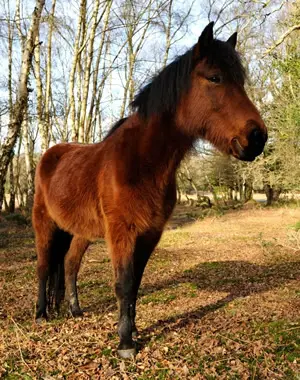History
The New Forest Pony gets its name from the New Forest that lies along the English coast between Southampton and Bournemouth in southwest Hampshire. This region comprises one of the largest areas of unenclosed land in southern England and today is a popular recreational destination for the general public. The New Forest ponies still roam its heaths, woodland and bogs as they have for centuries. It is, however, unknown as to how or when these fine ponies passed into private ownership.
New Forest ponies combine the characteristics of the other native British ponies such as strength, intelligence and agility with a narrower build, tractable temperament and speed. It is a recognized breed of the mountain and moorland ponies of the British Isles. Not only was the breed influenced by native British stock but also the various infusions of blood from horses that crossed Britian during various periods of history.
It was not until the end of the nineteenth century that systematic efforts were made to improve the breed. In 1891, the Society for the Improvement of New Forest Ponies was founded. In 1906, the Burley and District New Forest Pony and Cattle Breeding Society started to register mares and young stock, and the first studbook was published in 1910.
At that time stallions from other native breeds were used to improve breed and the early studbooks show a curious assortment of sires.
From 1914 to 1959 registration were recorded in the National Pony Society's studbook. In 1938 the two local societies merged and no outside blood has been permitted since the mid 1930s. In 1960, the New Forest Pony Breeding and Cattle Society started to publish its own studbook and has continued to the present.
Today, as in the past, these wild, though privately owned ponies roam their ancient homeland unencumbered. Their owners pay for grazing rights in the forest and each fall the ponies are rounded up and evaluated for breeding by the New Forest Pony Breeding and Cattle Society. This organization continues to oversee the management and breeding of the ponies in order to ensure their survival.
In recent years an increasing number of New Forest ponies have been bred in private studs outside the forest and many ponies have been exported. Presently there are flourishing studs of registered New Forest ponies not only in the United Kingdom but throughout Europe, Canada and Australia.
Behavior
The New Forest Pony is considered an ideal mount for families seeking a horse appropriate for both children and adults and one that is skilled in adapting to the various skill levels of various riders.
Function
The New Forest pony and related crossbreeds are still the "working pony of choice" for local farmers and commoners, as their sure-footedness, agility, and sound sense will carry them (and their rider) safely across the varied and occasionally hazardous terrain of the open Forest, sometimes at great speed, during the autumn drifts. New Forest ponies also are used today for gymkhanas, show jumping, cross-country, dressage, driving, and eventing.






